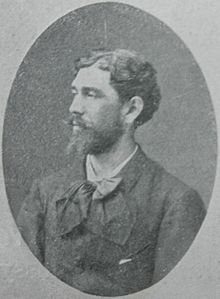Ion Mincu
Ion Mincu | |
|---|---|
 | |
| Born | December 20, 1852 |
| Died | December 6, 1912(aged 59) |
| Resting place | Bellu Cemetery,Bucharest |
| Nationality | Romanian |
| Alma mater | School of Roads and Bridges École des Beaux-Arts |
| Occupation | Architect |
| Buildings | Palace of Justice Kiseleff Roadside Buffet Central Girls' School |
| Projects | Leading role in creating theRomanian Revival style |
Ion Mincu(Romanian pronunciation:[iˈonˈmiŋku];December 20, 1852 – December 6, 1912 inBucharest) was aRomanianarchitect known for having a leading role in the development of theRomanian Revival style.Most of his projects are located inBucharest,including hismain works,thePalace of Justice,theKiseleff Roadside Buffet,and theCentral Girls' School.
Biography
[edit]Mincu was born in 1852 inFocșani,at the time inPutna County,Moldavia.He was the son of Pavel and Maria, and had three brothers and four sisters (one of them, Sultana, became the mother ofDuiliu Zamfirescu).[1]He studied from 1863 to 1871 atUnirea High School,in Focșani and from 1871 to 1875 at theSchool of Roads and Bridges,in Bucharest, becoming an engineer. From 1873 to 1877 he served as chief engineer for Putna County, residing in Focșani. During that time, he also worked on the construction of thePloiești–Predealroad (now part of theDN1road).[1]
Starting in 1877 Mincu pursued his studies inParis,first for a year at theÉcole Spéciale d'Architectureunder the guidance ofÉmile Trélat,and then at theÉcole des Beaux-Arts,having as teachersJulien Guadet,Remy de Louanges, and François Thierry-Lagrange. In 1883 he received an award from the Central Association of the French Architects, while in 1884 he received his architect diploma. Upon returning to Romania, he married in 1887, and had a daughter, Maria.[1]
He promoted a specific Romanian style in architecture, by integrating in his works the specific style of traditionalRomanian architecture.Mincu was the most important Romanian architect forArt NouveauandRomanian Revival architecture.[2]As a recognition to his importance in the Romanian school of architecture, since 1953, theIon Mincu University of Architecture and Urbanismin Bucharest bears his name.

From 1892 to 1912 he taught architecture and became one of the founding members of the Architecture School of the Romanian Architects Association. He was the teacher ofToma T. Socolescu,another remarkable Romanian architect. From 1903 to 1912 he served as president of the Romanian Architects Association.
From 1895 to 1899 he was deputy for Putna County in theParliament of Romania.[1]He died in Bucharest in 1912, and was buried in the city'sBellu Cemetery.
In 2012 he was elected posthumously a member of theRomanian Academy.[3]High schools in Focșani,Tulcea,andVaslui,as well as streets in Bucharest,Cluj-Napoca,Focșani, andOradeabear his name. The house where Mincu lived is now the residence of the Order of Romanian Architects.[4]
Works
[edit]

- Kiseleff Roadside Buffet,Bucharest (1882–1892). Located at the intersection ofȘoseaua Kiseleffwith Architect Ion Mincu Street, it now houses the Casa Doina Restaurant.[5]
- Lahovary House,Bucharest (1884–1886)
- Restoration ofMonteoru House,Bucharest (1887–1889)
- Vernescu House,Bucharest (1887–1889). For many years this was considered the most beautiful residential building in the city.[4]
- Manolescu-Vitzu House, Bucharest (1888)
- Ștefan Vlădoianu House, Bucharest (1889)
- Central Girls' School,Bucharest (1890)
- Interior decoration of thePalace of Justice,Bucharest (1890–1895)
- Interior decoration of theCathedral of Saints Peter and Paul,Constanța(1895)
- School No. 11 "Ion Heliade Rădulescu", Bucharest (1896). Constructed in Mincu's style by his student,Giulio Magni.[6]
- Robescu House,Galați(1896–1897)
- Villa Robescu,Sinaia(1897)
- Nicolae PetrașcuHouse,Piața Romană,Bucharest (1904)
- Galați County Prefecture,Galați (1905–1906)
- Commerce Bank building,Craiova(1906, finished byConstantin Iotzuin 1916). Now the Craiova City Hall.
- Restoration ofStavropoleos Monastery,Bucharest (1904–1910)
References
[edit]- ^abcd"Ion Mincu".arhivadearhitectura.ro(in Romanian).RetrievedJuly 25,2021.
- ^"Clădiri în stilul Art Nouveau din România".romanialibera.ro.March 6, 2018.
- ^"Membrii Post-Mortem ai Academiei Române".acad.ro(in Romanian).Romanian Academy.Archived fromthe originalon 2018-10-19.Retrieved2021-07-25.
- ^abTudose, Sorin (November 18, 2011)."Originea focșăneană a arhitectului Ion Mincu – sub semnul întrebării!".Ziarul de Vrancea(in Romanian).RetrievedJuly 26,2021.
- ^"Casa Doina: History".casadoina.ro.RetrievedAugust 2,2021.
- ^Andreescu, Crișan (September 1, 2020)."Dan Tudorache: Primăria Sectorului 1 a finalizat modernizarea Școlii" Ion Heliade Rădulescu ""(in Romanian). DC News.RetrievedJuly 26,2021.
